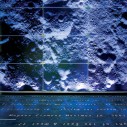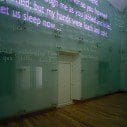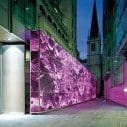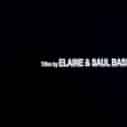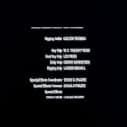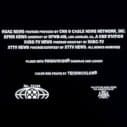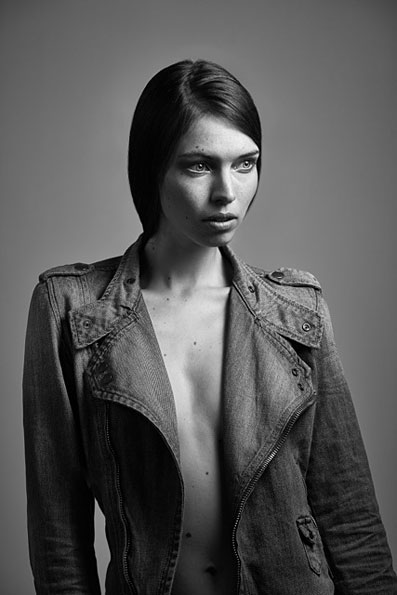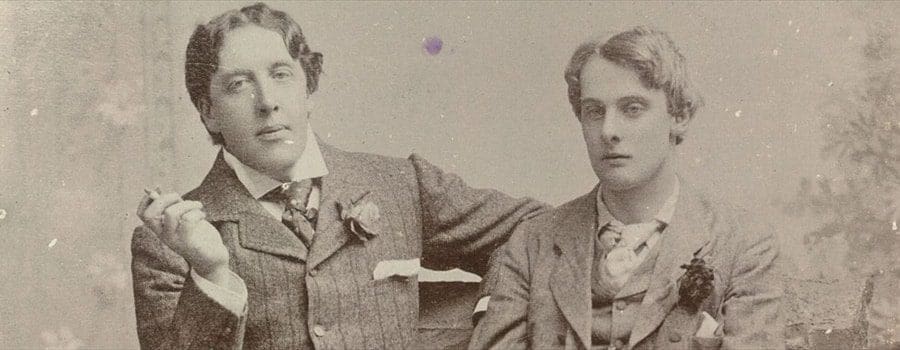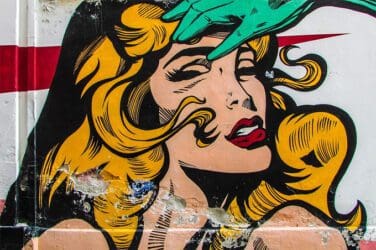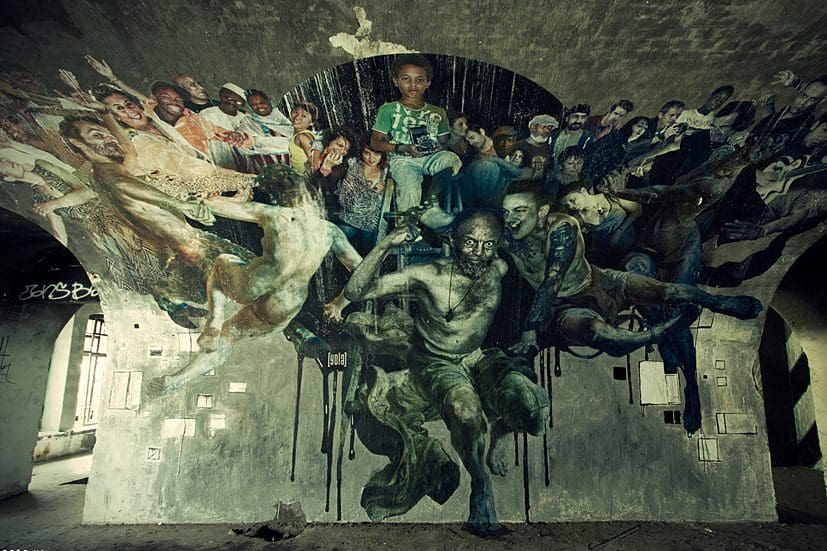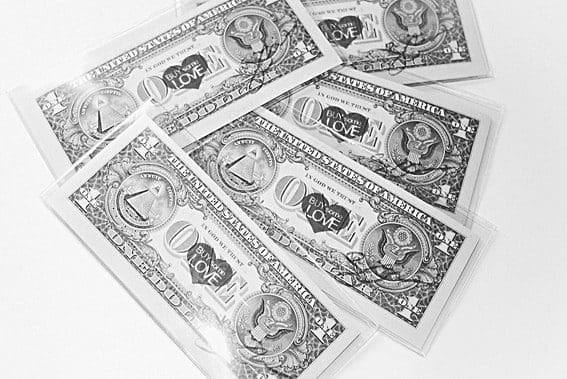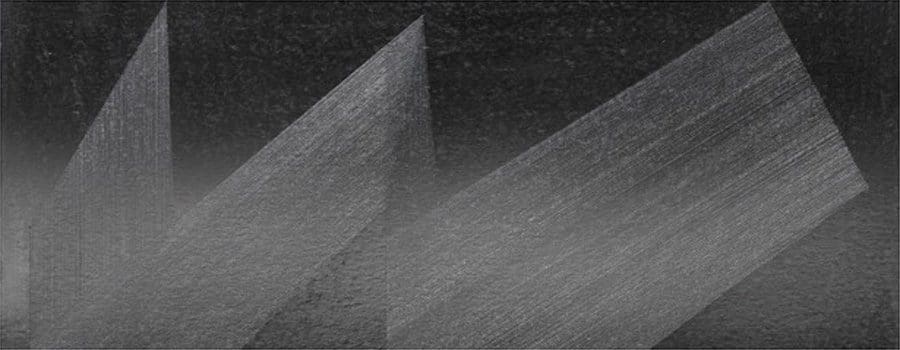Simon Patterson describes himself as a film fan, and he has experimented with video in the past, so it seems entirely appropriate that, on the subject of his approach to making art, he says:
‘Most making is editing. Usually there’s a problem – some projects you don’t know what you’re going to do with them, if they’re for someone else they might not like what you’ve done, and might have to put it in a drawer for another time…most work is editing an idea.’
We’re here to discuss The Dark Would exhibition also an anthology of poetry and text art created by curator and artist Philip Davenport, in which two paintings from Patterson’s Black List series appear. Patterson’s work features in both, so I ask him if has a long standing interest in poetry? This leads to the question of the intermediary space between the established disciplines of art and poetry which both exhibition and anthology inhabit. Davenport describes the artists and poets involved in the project as ‘people for whom language is itself a state of in-between-ness… artists who use language and poets who are artists’. Patterson certainly identifies with this notion: ‘the work I like the most is often almost not art…its approaching something else altogether…I like work which is on the brink of failure, on the brink of becoming something else. My own work can be on the brink of being graphic design [he pauses]. It’s where something is close to being something else or to falling apart. One reason I like that kind of work is that it’s a way in. When something is seamless it’s hard…’
Patterson talks with admiration of Xu Bing’s work, which offers a tangential insight into his own interest in language. The Chinese artist shares an interest in slippage, and in pushing the relationship between signifier and signified to breaking point. Language is a theme that ties a lot of Patterson’s projects together. He still makes versions of the name paintings, early iterations of which Elizabeth Taylor and Richard Burton were included in Damien Hirst’s Freeze show, but his understanding of them has changed over time. ‘I started out using text in naive way, from a position of youthful ignorance, as you do as a student, without fear. Originally I understood them as a kind as portraiture but I soon realised that you don’t necessarily conjure up an image of a person by evoking their name, for instance if they’re an artist you might conjure up a work by them or for a politician a political event. So they became, for me, more like history paintings. It was also about the sound associations, like naff concrete poetry, and about slippage (is it this person or that person?) and about language standing in for objects or things or people’.
The Black List paintings employ a similar mechanism but almost in reverse, I suggest, while Elizabeth Taylor might have conjured a different image for every viewer, in the case of this homage to unsung figures in cinema history, many visitors may struggle to recognise many names beyond the few (semi) household names such as Saul and Elaine Bass. Patterson locates the origin of the work in an earlier piece for the BBC, which presented names of the corporation’s backroom workers and got him interested in playing with anonymity and the idea that these people are in one sense household names and in another unrecognisable. Patterson explains that some of the names cited in the paintings were on the Hollywood black list, the list of entertainment industry professionals denied work because they were suspected of Communist sympathies, while some weren’t, creating a further ambiguity.
The works clearly relate to McCarthy era abuses of power, but Patterson also finds resonances with today’s political climate, particularly with the war on terror (re-named, he notes. Like McCarthy, Obama clearly understands the power of language). The comparison is clear to see, the conjuring of an enemy for political gain, and Patterson’s anger at the situation clearly played a role in his decision to make the works.
There are other forces and interests at play here, however, that relate back to the artist’s interest in language. He describes the works as ‘book ends without the books’, and notes that they speak of the non-space that we inhabit in between the escapist displacement of the watching of a film and finding our feet in the outside world. Once again we find ourselves in a space of inbetween-ness, a state mirrored by the canvases themselves, which hover, as David Campany has noted, between canvas and screen. The feeling of linguistic disconnection Patterson likes to play with is also echoed by the glow of the letters, suggesting a bad transfer or that the projection is slightly out of sync.
As our conversation draws to a close, I ask Patterson about the origins of The Dark Would anthology and exhibition, which lie in Philip Davenport’s ‘strong sense of time flowing by’ upon turning fifty, the ‘dark would’ constituting a reference to Dante’s description of his mid-life crisis feeling like being lost in a dark wood. Patterson offers a typically considered reply: ‘I am in the middle in terms of age but I don’t think that way in terms of the work. I move from idea to idea. I know a few people who’ve written life plans, which I’m impressed by, but I’m not that organised. Work is a controlling mechanism for me; order in the work can create order in the world even if it’s challenging a wider order… you create your own history in the work and police that history, you repair older works, revisit them–it’s enjoyable but ultimately you want to move on.’
For more information on The Dark Would click here
words Laura Purseglove


